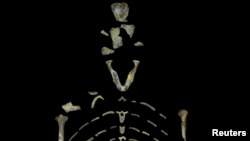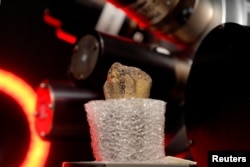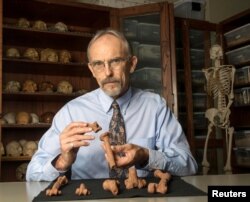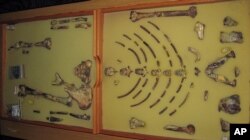Scientists using sophisticated scanning technology on the fossil bones of the ancient human ancestor from Ethiopia dubbed "Lucy" have determined that she was adept at climbing trees as well as walking, an ability that in her case may have proven fatal.
Researchers on Wednesday announced the results of an intensive analysis of the 3.18 million-year-old fossils of Lucy, a member of a species early in the human evolutionary lineage known as Australopithecus afarensis.
The scans of Lucy's arm bones showed they were heavily built, like chimpanzees, indicating that members of this species spent significant time climbing in trees and used their arms to pull themselves up in the branches.
Australopithecus afarensis possessed a combination of ape-like and human-like traits. Scientists already knew its feet were adapted for walking upright on two legs, rather than grasping trees, but had wondered about whether it still spent time in trees like its ancestors.
Chimpanzees, the closest living relative of humans, spend a lot of time in trees.
The researchers performed high-resolution X-ray CT scans on Lucy's fossils at the University of Texas and compared the findings to data on the bones of modern humans and chimpanzees.
"The debate about whether or not Lucy climbed trees has been raging ever since her discovery 42 years ago this month — our study brings that debate to a close," said University of Texas paleoanthropologist John Kappelman, one of researchers in the study published in the journal PLOS ONE.
The 1974 discovery of Lucy created a scientific sensation and shed light on early stages of human evolution. Our species, Homo sapiens, appeared in Africa 200,000 years ago.
"Our analysis required well-preserved upper and lower limb bones from the same individual, something very rare in the fossil record," added the study's lead author, Christopher Ruff, a professor of functional anatomy and evolution at the Johns Hopkins University School of Medicine in Baltimore.
The findings fit nicely with a study published in August by Kappelman and other researchers that concluded that Lucy herself may have died after a fall from a tree, based on bone fractures detected in the fossils.
Kappelman has hypothesized that Lucy, about 3-1/2 feet tall (1.07 meters), foraged on the ground and sought nightly refuge in trees. Her injuries indicated she fell from a height of more than 40 feet (12 meters), that earlier study found.
"It may seem unique from our perspective that early hominins [members of the human evolutionary lineage] like Lucy combined walking on the ground on two legs with a significant amount of tree climbing, but Lucy didn't know she was unique," he said.











